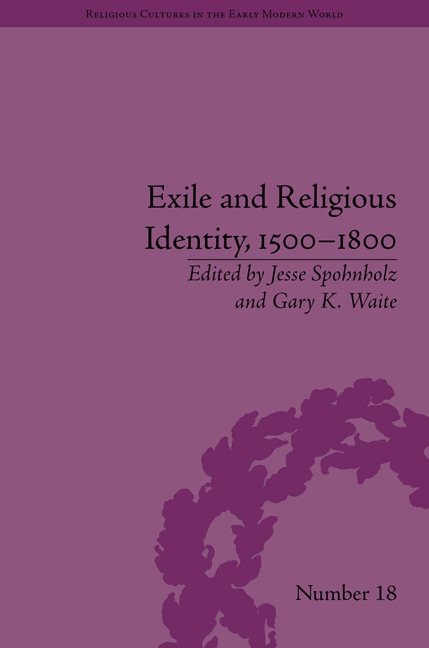Book contents
- Frontmatter
- CONTENTS
- Acknowledgements
- List of Contributors
- List of Figures and Tables
- Introduction
- Part I The Experience of Exile and the Consolidation of Religious Identities
- Part II The Experience of Exile and the Destabilization of Religious Identities
- 5 Dirck Volckertz Coornhert: Exile and Religious Coexistence
- 6 Isaac Nabrusch, Christian and Jew: A Pious Man at Life's Many Crossroads
- 7 Justus Velsius Haganus: An Erudite but Rambling Prophet
- 8 Instability and Insecurity: Dutch Women Refugees in Germany and England, 1550–1600
- 9 Heresy and Commercial Exchanges in Early Modern Northern Spain
- Part III The Memory of Exile
- Notes
- Index
6 - Isaac Nabrusch, Christian and Jew: A Pious Man at Life's Many Crossroads
from Part II - The Experience of Exile and the Destabilization of Religious Identities
- Frontmatter
- CONTENTS
- Acknowledgements
- List of Contributors
- List of Figures and Tables
- Introduction
- Part I The Experience of Exile and the Consolidation of Religious Identities
- Part II The Experience of Exile and the Destabilization of Religious Identities
- 5 Dirck Volckertz Coornhert: Exile and Religious Coexistence
- 6 Isaac Nabrusch, Christian and Jew: A Pious Man at Life's Many Crossroads
- 7 Justus Velsius Haganus: An Erudite but Rambling Prophet
- 8 Instability and Insecurity: Dutch Women Refugees in Germany and England, 1550–1600
- 9 Heresy and Commercial Exchanges in Early Modern Northern Spain
- Part III The Memory of Exile
- Notes
- Index
Summary
Religious controversies shaped everyone's life in early modern Europe, from daily issues to formalized diplomacy and war. Disputes and negotiations over religious beliefs, values and morals encouraged the phenomena of adaptation and integration as well as discipline and repression, or even for others, of dissimulation and conflict. All of them affected the everyday life of ordinary people and created environments where conflict was produced by a wide range of combined factors. However, some European territories served as sites of cultural exchange. In regions of relatively homogeneous religious environments, cultural hybridization often even tested religious institutions' very nature. Sometimes this happened in Catholic areas with the Counter-Reformation confraternities. In some regions of Catholic Europe, by cleansing perceived popular beliefs and moral contaminations, civil and ecclesiastical authorities tried to adjust these institutions to what they considered religious orthodoxy.
Years ago, Natalie Davis proposed a suggestive analytical framework to understand how religious controversies affected the everyday life of individuals. She focused her research on investigating transitions within individual lives to strengthen our understanding about how global problems affected people's ordinary lives on a microhistorical level. Further research has added to this by showing how cultural and religious hybridization offers individuals vital options. Cultural encounters between Europeans and overseas civilizations also produced specific expressions of this phenomenon.
This essay uses Davis's framework to analyse the life transitions of one man, Isaac Nabrusch, using the fi les of the Roman Inquisition, which investigated his case in 1673.
- Type
- Chapter
- Information
- Exile and Religious Identity, 1500–1800 , pp. 81 - 96Publisher: Pickering & ChattoFirst published in: 2014

